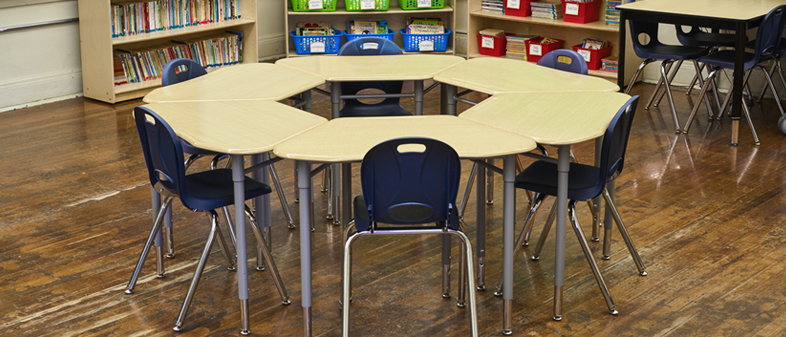
You can optimize for active learning, even in small spaces
When I talk with teachers about their classroom furnishing needs, I commonly hear the words, "If I had more room, I would...". As students file into class, they squeeze into spaces intended to maximize the number of bodies that can fit into rows of desks that all face the front of the room. It seems that space for things like backpacks, projects and laptops wasn't a concern when the rooms were originally designed. How do educators work within constraints like these to optimize for 21st century learning in their classrooms? Teachers are problem solvers, and I have picked up tips from many who creatively arrange their classrooms to improve their students' learning experiences. Here are some of the lessons educators have taught me about the innovative use of space.
Making the most of your space
Active learning frequently requires student collaboration, so teachers often cluster individual desks together, allowing students to communicate in small groups. When desks are arranged into clusters, students have better opportunities to interact. The compact group units also open walkways for teachers to move where they are most needed, and allow students to access any stored items that might be required. Some types of desks are better designed than others for student group work. However, educators can optimize group arrangements, regardless of whether their desks are more suited for individual or collaborative work.
Rectangular desks are designed for individual work, but educators have found ways to cluster them into configurations that allow all students to participate in groups. When arranging rectangular desks, I have seen teachers employ a "rule of five" for small group work. Educators optimize their five-student clusters by bringing four desks to form a tight square, with a fifth desk pushed up against one side of that square. Although it might seem like that fifth student would be an outlier, this is not the case. Research shows that the addition of that fifth participant reduces the chances of students splintering into pairs. Group members are close enough to each other that every student must be accountable. The compact cluster creates equal opportunities for each student to participate, since no student is hidden from any other student's line of sight.
Some desks are designed specifically for collaborative work with shapes that afford ample individual workspace, while greatly reducing the footprint of group configurations. These collaborative desks give educators more freedom to create the space they need because the desks are designed to fit together while keeping walkways clear. When desktops are trapezoid-shaped, for example, teachers can get away from the "rule of five" by fitting desks into six- or eight-person groups where every student can have an equal chance to participate. Even with larger groups, clear sightlines and close seating arrangements keep every participant accountable. If desired, trapezoid desks can also fit into more compact clusters of three, four and five, opening larger walkways than would be created with rectangular desks in similar groupings. Other desks are similarly designed with specific angles or curved surfaces that fit together to optimize group participation and to create room for effective interactions in an active learning environment.
Ergonomic seating
Students learn more effectively when discomfort doesn't disrupt their focus. Active learning may occasionally allow students to stand, but they will mainly sit while doing their work throughout the school day. Because of this, the type of seating students use will be the primary driver of their comfort and ergonomics, especially late in the day after they have worked through class periods that run from the early morning to the middle of the afternoon. Many students need to keep their bodies active to maintain focus, and there are seating options that give students the movement they need while allowing them to remain seated and mentally engaged. Active learning stools have rounded bases that allow students to shift into different positions without distracting others around them. Rocker school chairs encourage students to sway back and forth while providing a back rest for additional comfort. Chairs with soft plastic shells provide flexible back support as students change positions. When casters are fitted to the plastic chairs, students can release energy by rolling slightly as they interact in their classes. Learners do not all have the same ergonomic needs, and a variety of seating options can make a substantial difference in your students' comfort and performance. If budgetary constraints make it difficult to offer a variety, incorporating even a few active seating options could benefit those who learn best while moving.
Customizing student work spaces
Even when part of a group, students feel valued when they educators place importance on their individual needs. Work spaces contribute to this feeling of individuality when students have enough personal working space, and when they can customize some aspect of their personal areas. We often see bursts of personal expression in the business world when employees put up photos, desk calendars, or other small mementos in their otherwise uniform work stations. Students can similarly express their individuality when their work spaces provide enough room for them to set down a small personal item in a corner. Allowing younger students to decorate some aspect of their space with contact paper or stickers can reinforce each child's unique gift to the classroom. Even when work spaces are temporary locations for a single class period, glimmers of personal expression create more inviting spaces for each student to encounter.
Increasing project time with efficient storage
Educators often tell me that efficiency is a substantial concern, especially when doing project work. A 50-minute class period can contain as little as 30-minutes of learning if students need five to 10 minutes to access their materials at the beginning of class and another five to 10 minutes to clean up and store materials at the end. Educators can make more efficient use of their class time when they employ greater mobility and organization for their storage units. Teachers can reduce access time at the beginning of class when they use mobile storage units that easily wheel around the room. When these units contain bins of different sizes, mobile storage can house a greater variety of tools and materials, reducing the need for students to travel to other shelving throughout the room. Efficiency also increases when entire bins can be removed from the mobile units and placed at the group work area. When participants must access tools and materials from fixed shelving units, they gain more project time if locations for supplies and materials remain consistent. Labels on shelves or bins help students learn and remember these locations, and color-coding could reinforce the organizational scheme, especially for younger learners.
21st century solutions for your space
Educators have proven to me that vibrant, active learning spaces can exist in older classrooms, mobile units, or other spaces designed for more traditional educational approaches. Creative space arrangements, attention to ergonomics, a nod to individuality and efficient organization can create opportunities for more participation and better student engagement. The School Outfitters team enjoys working with educators to learn what they need and deliver solutions for 21st century learning through a variety of products including our Learniture, Sprogs and Egghead brands. We enjoy sharing this knowledge with kindred spirits who share our excitement about creating spaces for active, student-centered learning.



